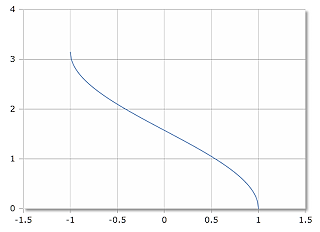ACos - Arccosine (Inverse Cosine)
Online calculator for calculating the angle to the cosine
Arccosine Calculator
Instructions
Enter the value of the cosine (between -1 and +1), select the unit of measure (degrees or radians) and click Calculate.
Arccosine - Overview
Value Range
The value of the argument must be between -1 and +1. The result is given in degrees (full circle = 360°) or radians (full circle = 2 · π).

Inverse cosine, scale in radians
Definition
The arccosine (Arccos or Acos) is the inverse function of the cosine function. It calculates the angle for a given cosine value.
\(\displaystyle y = \arccos(x) \Leftrightarrow \cos(y) = x \)
with \( x \in [-1, 1] \) and \( y \in [0, \pi] \) (radians)
Conversion
From radians to degrees:
\(\displaystyle \text{Degrees} = \frac{\text{Radians} \cdot 180°}{\pi} \)
|
|
Description of the Arccosine
Fundamentals
The arccosine (\( \arccos \) or \( \text{acos} \)) is the inverse function of the cosine function. It calculates the angle for a given cosine value. Acos(x) returns the corresponding angle in radians.
Mathematical Definition:
\(\displaystyle y = \arccos(x) \)
means
\(\displaystyle \cos(y) = x \)
Calculating the Cosine Value
The cosine is a trigonometric function related to a right triangle. In a right triangle, the cosine of an angle α is the ratio of the length of the adjacent side to the hypotenuse:
\(\displaystyle \cos(\alpha) = \frac{\text{Adjacent side}}{\text{Hypotenuse}} \)
Important: The cosine value is always between -1 and 1, and an angle of 90 degrees has a cosine value of 0.
Detailed Example
Example 1: Calculate Cosine Value
Given:
A right triangle with:
- Adjacent side: \( b = 6 \)
- Hypotenuse: \( c = 20 \)
Calculating the cosine:
\(\displaystyle \cos(\alpha) = \frac{6}{20} = 0.3 \)
Example 2: Calculate Angle
Task:
Calculate the angle α for \( \cos(\alpha) = 0.3 \)
In radians:
\(\displaystyle \alpha = \arccos(0.3) \approx 1.266 \text{ rad} \)
Conversion to degrees:
\(\displaystyle \alpha = \frac{1.266 \cdot 180°}{\pi} \approx 72.54° \)
Conversion Formula
From radians to degrees:
\(\displaystyle \text{Degrees} = \frac{\text{Radians} \cdot 180°}{\pi} \)
Properties
- Domain: \( x \in [-1, 1] \)
- Range: \( y \in [0, \pi] \) (radians) or \( [0°, 180°] \)
- Monotonicity: Strictly monotonically decreasing
- Special values:
- \( \arccos(1) = 0 \)
- \( \arccos(0) = \frac{\pi}{2} \approx 90° \)
- \( \arccos(-1) = \pi \approx 180° \)
Practical Applications
- Geometry: Angle calculation in triangles
- Navigation: Course determination and positioning
- Physics: Calculation of force angles
- Computer graphics: 3D rotations and projections
- Robotics: Joint angle calculations
- Astronomy: Calculation of celestial coordinates
Important Note
Note the notation: In programming, inverse trigonometric functions are often called with the abbreviated forms asin, acos, atan. The notations sin−1(x), cos−1(x), tan−1(x) can be confusing as they conflict with the notation for reciprocal trigonometric functions.
|
|